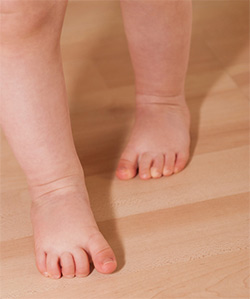- March 9, 2018
- Posted by: admin
- Category: General News
Physical therapy for children with gait problems focuses on implementing mobility and strengthening exercise programs, overseeing orthotic use through open communication with their physician and orthotist, balance training, and gait training. There are numerous studies available that support the effectiveness of physical therapy in improving the quality of gait in children whose diagnoses include gait abnormality.
 Gait training includes exercises which ensure that the child has enough physical strength to support himself in an upright position. Upper extremity, core, and lower extremity work is crucial to allow for the child to gain as much independence in assuming, maintaining, and weight-shifting in an upright position. Musculoskeletal alignment and integrity are also important. A physical therapist works alongside physicians and orthotists to determine if the child needs any support during ambulation. The options run from a simple shoe insert, to a more supportive ankle-foot orthosis (AFO), to a more complex hip/knee/ankle/foot orthosis (HKAFO) with lumbar or thoraco-lumbar support. There are instances wherein the rehabilitation team may decide on dynamic orthoses vs traditional ones. The main difference is that while both provide stability, the former also allows for biomechanical return of energy during gait to support the child during functional execution of a step. New assistive technology, including functional electrical stimulation units for the lower extremities, are now being incorporated into physical therapy in an effort to improve a child’s gait by providing timed stimulation of key muscle groups during certain parts of the gait cycle. Selecting an appropriate assistive device and teaching the child how to use it is also a crucial part of gait training. Based on the child’s current level of strength, endurance and functional needs, the physician and physical therapist work together to determine which type of assistive device is appropriate for him/her. The diagnosis of the child also affects gait training. The natural progression of a condition, including a possible decline in functional skills like those who are diagnosed with dystrophies or cerebellar degeneration to name a few, allows the physical therapist to create an appropriate treatment plan.
Gait training includes exercises which ensure that the child has enough physical strength to support himself in an upright position. Upper extremity, core, and lower extremity work is crucial to allow for the child to gain as much independence in assuming, maintaining, and weight-shifting in an upright position. Musculoskeletal alignment and integrity are also important. A physical therapist works alongside physicians and orthotists to determine if the child needs any support during ambulation. The options run from a simple shoe insert, to a more supportive ankle-foot orthosis (AFO), to a more complex hip/knee/ankle/foot orthosis (HKAFO) with lumbar or thoraco-lumbar support. There are instances wherein the rehabilitation team may decide on dynamic orthoses vs traditional ones. The main difference is that while both provide stability, the former also allows for biomechanical return of energy during gait to support the child during functional execution of a step. New assistive technology, including functional electrical stimulation units for the lower extremities, are now being incorporated into physical therapy in an effort to improve a child’s gait by providing timed stimulation of key muscle groups during certain parts of the gait cycle. Selecting an appropriate assistive device and teaching the child how to use it is also a crucial part of gait training. Based on the child’s current level of strength, endurance and functional needs, the physician and physical therapist work together to determine which type of assistive device is appropriate for him/her. The diagnosis of the child also affects gait training. The natural progression of a condition, including a possible decline in functional skills like those who are diagnosed with dystrophies or cerebellar degeneration to name a few, allows the physical therapist to create an appropriate treatment plan.
With all of the scientific breakthroughs in orthotic and assistive technologies, it is a very exciting time for rehabilitation doctors, orthotists and physical therapists alike to see how the profession can further gait training strategies and improve the lives of children who have difficulties in ambulation.
